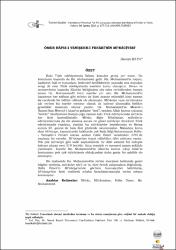| dc.contributor.author | Kaya, Hasan | |
| dc.date.accessioned | 2022-05-11T14:32:26Z | |
| dc.date.available | 2022-05-11T14:32:26Z | |
| dc.date.issued | 2014 | |
| dc.identifier.issn | 1308-2140 | |
| dc.identifier.issn | 1308-2140 | |
| dc.identifier.uri | https://app.trdizin.gov.tr/makale/TWpZNU9ETTJOZz09 | |
| dc.identifier.uri | https://hdl.handle.net/20.500.11776/7542 | |
| dc.description.abstract | Eski Türk edebiyatında İslâmî konular geniş yer tutar. Bu konuların başında da Hz. Muhammed gelir. Hz. Muhammed'in hayatı, hadisleri, hâl ve tutumları, bedensel özelliklerinin yanında ona duyulan sevgi de eski Türk edebiyatında eserlere konu olmuştur. Divan ve mesnevilerin başında Allah'ın birliğinden söz eden tevhidlerden hemen sonra Hz. Muhammed'i öven naatlar yer alır. Hz. Muhammed'in hayatının her safhası gibi mi'râcı da kimi zaman müstakil kimi zaman da eserlerde bir bölüm hâlinde ele alınmıştır. Mi'râciye veya mi'râcnâme adı verilen bu eserler mensur olarak da kaleme alınmakla birlikte genellikle manzum olarak yazılır. Hz. Muhammed'in Mescid-i Haram'dan Mescid-i Aksa'ya gidişine "isrâ", oradan Allah katına çıkışına "mi'râc" denilmesine karşın çoğu zaman eski Türk edebiyatında mi'râcla her ikisi kastedilmiştir. Mi'râc, diğer Müslüman milletlerin edebiyatlarında da ele alınmış ancak en güzel mi'râciye örnekleri Türk edebiyatında yazılmış, yazılan bu mi'râciyeler bestelenmiş ve Recep ayının 27. gecesi ile bazı dinî günlerde okunmuştur. Makaleye konu olan Mi'râciye, kaynaklarda hakkında çok fazla bilgi bulunmayan Hâfızı Yenişehr-i Fenârî olarak anılan Hâfız Ömer tarafından 1791'de yazılmış bir eserdir. Mi'râciye'nin tespit edilebilen dört nüshası vardır. Pek çok mi'râciye gibi sade sayılabilecek bir dille samimî bir üslupla kaleme alınan eser 319 beyittir. Aruz vezniyle ve mesnevi nazım şekliyle yazılmıştır. Eserde Hz. Muhammed'in Allah'ın katına çıkıp Allah'la konuşması pek çok mi'râciyede olduğundan daha geniş bir şekilde ele alınmıştır. Bu makalede Hz. Muhammed'in mi'râc mucizesi hakkında genel bilgiler verilmiş, mi'râciye türü ve bu türe örnek çalışmalara değinilmiş, Hâfız Ömer'in Mi'râciye'sinde görülen hususiyetler belirtilmiş, Mi'râciye'nin özeti verilerek nüsha karşılaştırmasıyla metni ortaya konmuştur. | en_US |
| dc.description.abstract | Islamic topics have an extensive place in Turkish literature. Hz. Muhammed is at the beginning of these topics. Besides the life, hadiths, states, attitudes and physical features of him, love of him has been included in the works of Turkish literature. At the beginning of divan literature works and Masnavi, right after the Tevhids (oneness) there are naats, special poems which praise Hz. Muhammed. Like all of the other stages of Hz. Muhammed's life, his mi'râc (ascension) is sometimes discussed separately or as chapters. Although these works that are called mi'râciye or mi'râcnâme, are written in the shape of prose, they are generally written in verse. Hz. Muhammed's walk to Mescid-i Aksa from Mescid-i Haram is called "isrâ", and his ascension into the presence of Allah is called "mi'râc"; but in old Turkish literature, these two processes are generally discussed as one. Mi'râc are also discussed in the literatures of other Muslim nations, but the most beautiful mi'râciye examples are written in Turkish literature; these mi'râciyes are composed and sang at the 27th night of Recep month and in some religious days. The Mi'râciye which is the topic of our article is a work written by Hâfız Ömer, who is referred as Hâfız-ı Yenişehr-i Fenârî, in 1791; there is not detailed information about him in the related literature. There are four copies of Mi'râciye that could be found. The work, which is written in a simple language and in an intimate style, which is similar to many mi'râciyes, is made of 319 couplets. It is written as aruz wezni and masnavi writing style. In the work, the process of Hz. Muhammad ascension into the presence of Allah and his conversation with him is discussed in more details than many Mi'râciyes. In this article, general information is given about Hz. Muhammed's mi'râc miracle, Mi'râciye type is discussed and examples are given. Characteristics of Hâfız Ömer's Mi'râciye are presented, summary of the Mi'râciye is given and the text is presented through comparing copies. | en_US |
| dc.language.iso | tur | en_US |
| dc.rights | info:eu-repo/semantics/openAccess | en_US |
| dc.title | Ömer Hâfız-I Yenişehr-İ Fenârî'nin Mi'râciyesi | en_US |
| dc.title.alternative | Mi'râciye Of Ömer Hâfiz-I Yenişehr-İ Fenârî | en_US |
| dc.type | article | en_US |
| dc.relation.ispartof | Turkish Studies (Elektronik) | en_US |
| dc.department | Fakülteler, Fen Edebiyat Fakültesi, Türk Dili ve Edebiyatı Bölümü | en_US |
| dc.identifier.volume | 9 | en_US |
| dc.identifier.issue | 6 | en_US |
| dc.identifier.startpage | 677 | en_US |
| dc.identifier.endpage | 718 | en_US |
| dc.institutionauthor | Kaya, Hasan | |
| dc.identifier.trdizinid | TWpZNU9ETTJOZz09 | en_US |



















